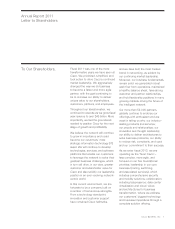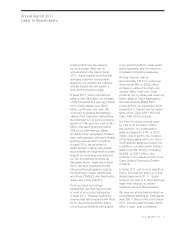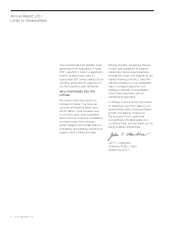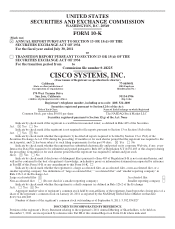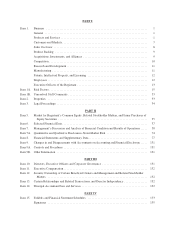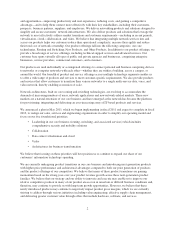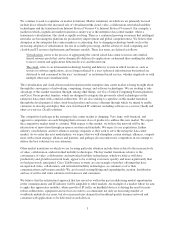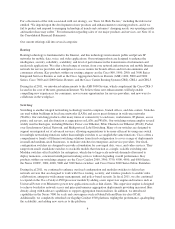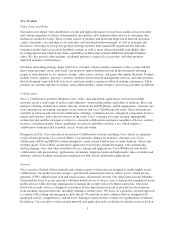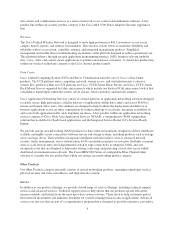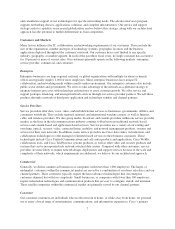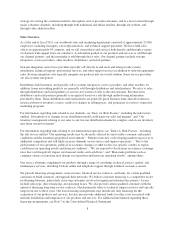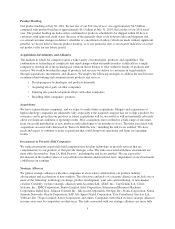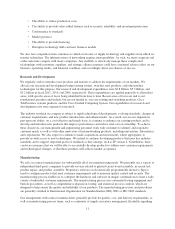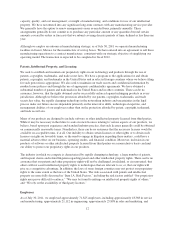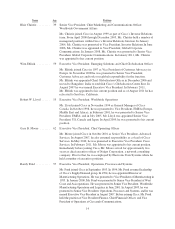Cisco 2011 Annual Report Download - page 12
Download and view the complete annual report
Please find page 12 of the 2011 Cisco annual report below. You can navigate through the pages in the report by either clicking on the pages listed below, or by using the keyword search tool below to find specific information within the annual report.For a discussion of the risks associated with our strategy, see “Item 1A. Risk Factors,” including the risk factor
entitled “We depend upon the development of new products and enhancements to existing products, and if we
fail to predict and respond to emerging technological trends and customers’ changing needs, our operating results
and market share may suffer.” For information regarding sales of our major products and services, see Note 16 to
the Consolidated Financial Statements.
Our current offerings fall into several categories:
Routing
Routing technology is fundamental to the Internet, and this technology interconnects public and private IP
networks for mobile, data, voice, and video applications. Our routing products are designed to enhance the
intelligence, security, reliability, scalability, and level of performance in the transmission of information and
media-rich applications. We offer a broad range of routers, from core network infrastructure and mobile Internet
network for service providers and enterprises to access routers for branch offices and for telecommuters and
consumers at home. Key products within our routing category are the Cisco 800, 1900, 2900, and 3900 Series
Integrated Services Routers as well as the Cisco Aggregation Services Routers (ASR) 1000, 5000 and 9000
Series; Cisco 7600 and 12000 Series Routers; and the Cisco Carrier Routing System (CRS), CRS-1 and CRS-3.
During fiscal 2011, we introduced enhancements to the ASR 9000 System, which complement the Cisco CRS-3
located in the core of the next-generation Internet. We believe these new enhancements will help enable
compelling new experiences for consumers, new revenue opportunities for service providers, and new ways to
collaborate in the workplace.
Switching
Switching is another integral networking technology used in campuses, branch offices, and data centers. Switches
are used within buildings in local-area networks (LANs) and across great distances in wide-area networks
(WANs). Our switching products offer many forms of connectivity to end users, workstations, IP phones, access
points, and servers, and also function as aggregators on LANs and WANs. Our switching systems employ several
widely used technologies, including Ethernet, Power over Ethernet, Fibre Channel over Ethernet (FCoE), Packet
over Synchronous Optical Network, and Multiprotocol Label Switching. Many of our switches are designed to
support an integrated set of advanced services, allowing organizations to be more efficient by using one switch
for multiple networking functions rather than multiple switches to accomplish the same functions. Cisco offers a
comprehensive family of Ethernet switching solutions from fixed-configuration to cover a range of deployments
in small and medium-sized businesses, to modular switches for enterprises and service providers. Our fixed-
configuration switches are designed to provide a foundation for converged data, voice, and video services. They
range from small, standalone switches to stackable models that function as a single, scalable switching unit.
Modular switches offer flexibility for enterprises, which due to large-scale network demands often need to
deploy numerous, concurrent intelligent networking services without degrading overall performance. Key
products within our switching category are the Cisco Catalyst 2960, 3560, 3750, 4500, 4900, and 6500 Series;
the Nexus 1000V, 3000, 4000, 5000 and 7000 Series switches; and Cisco Nexus 2000 Series Fabric Extenders.
During fiscal 2011, we continued to enhance our fixed configuration and modular switches to deliver key
network services that are designed to work with Cisco routing, security, and wireless products to enable video
collaboration, enterprise-wide energy management, and policy-based security. In fiscal 2011, we also continued
to expand on the Cisco Catalyst 4500 processor module by adding a new supervisor engine and features such as
Universal Power over Ethernet to power new applications such as thin clients. This supervisor engine is designed
to achieve borderless network access and price-performance aggregation deployments providing increased fiber
density along with hardware capabilities to support aggregation functionalities. In addition, we introduced
capabilities in the Nexus 7000 for scale and convergence such as FabricPath and Director-class FCoE.
Additionally, we completely refreshed our flagship Catalyst 6500 platform, tripling the performance, quadrupling
the scalability, and adding new services to the platform.
4



